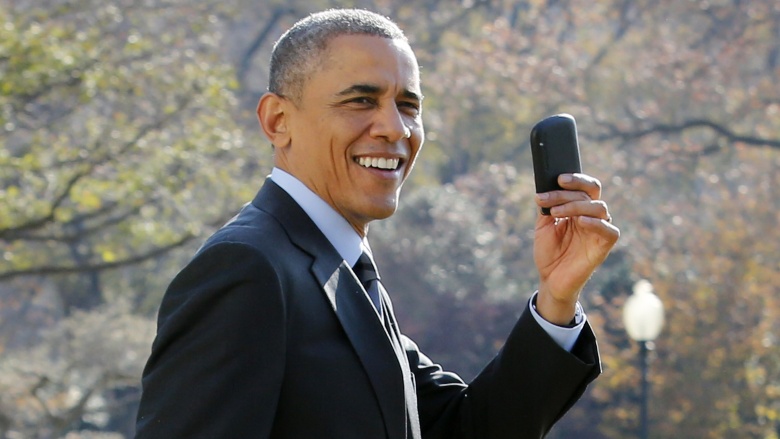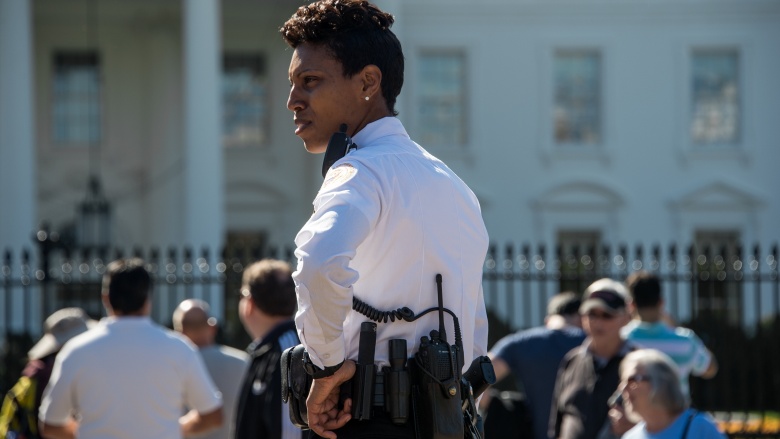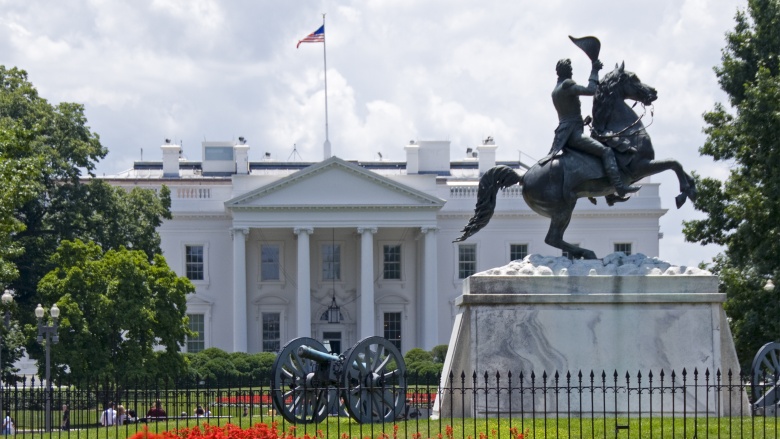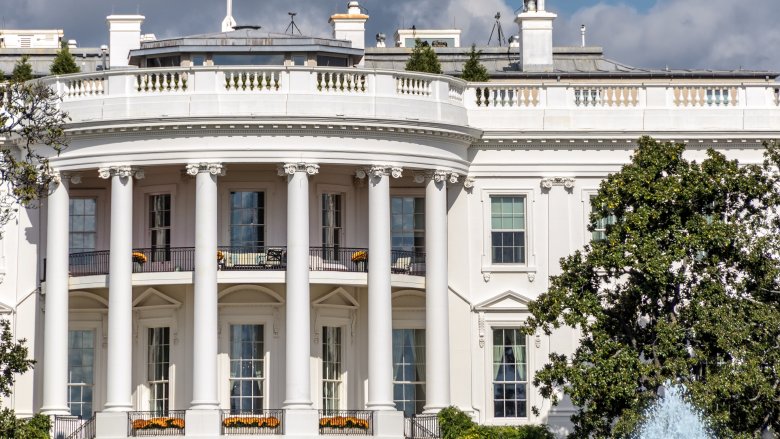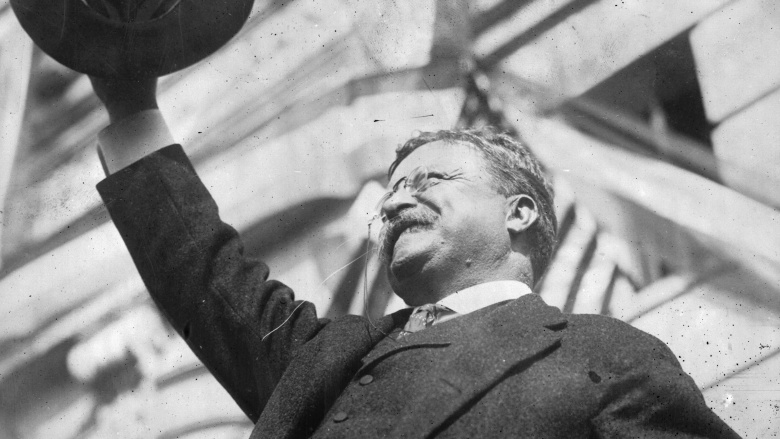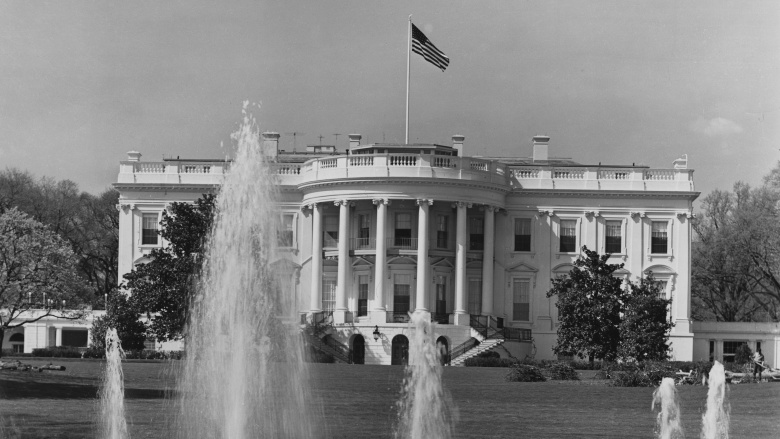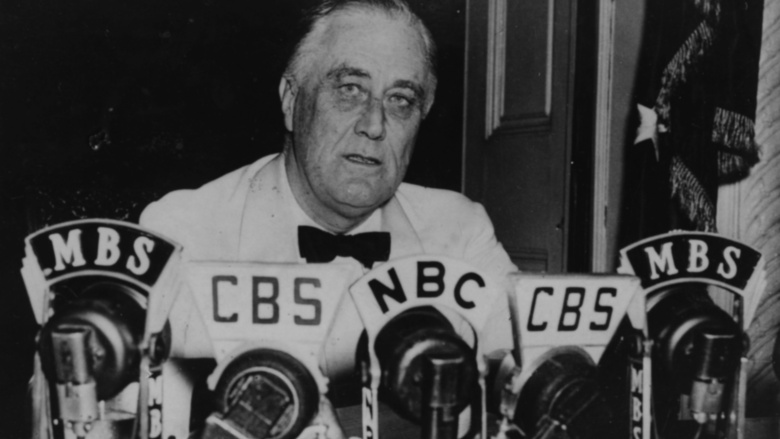10 Secrets Of The White House
The White House is one of the most recognizable buildings in the world, home to the President of the United States, and the symbol of American democracy. It's also one really weird place. In the past, we've looked at some pretty crazy facts about the White House, but since it's been around in one form or another since 1792, there's a lot more outlandish history there to cover. Such as ...
The White House runs on outdated technology
In a world of drones and NSA wiretaps, it's natural to assume government leaders are up-to-date with the latest technology. But up until 2015, the White House was woefully behind the times, technologically speaking. In fact, the WiFi was so bad, government officials couldn't even live-stream videos from the Roosevelt Room.
According to a New York Times article published in April 2016, White House employees only recently stopped using ancient equipment like black-and-white printers, old BlackBerries, and floppy disks. (Even worse, the Pentagon is still using floppy systems to operate nuclear bombers and intercontinental ballistic missiles.) So why is the White House so far behind the times? Well, it's all thanks to Crazy Uncle Bureaucracy. Four different organizations—the National Security Council, the Executive Office of the President, the Secret Service, and the White House Communications Agency—are all involved in taking care of White House tech. So any changes are pretty slow in coming.
But in 2015, things finally started to change. According to that Times article, employees were given new iPhones, 13,000 pounds of useless ethernet cables were ripped out of the walls, and the WiFi is finally up to speed. And once Pentagon officials finally get rid of those floppy disks in 2017, we can all finally breathe a little bit easier.
The White House has its own police force
Secret Service gets all the glory, but the United States Secret Service Uniformed Division might have an even bigger job. While the Secret Service directly protects the president, the Uniformed Division is in charge of the entire White House. The group got started in 1922 under Warren G. Harding, and eight years later, Herbert Hoover combined the Police Force and the Secret Service into one. In the 1970s, the organization was renamed the Uniformed Division, and ever since then, they've been checking out visitors, patrolling the streets, and making sure the White House stays safe.
Clad in white shirts and black pants, there are over 1,300 employees working in the Uniformed Division today. While many operate out of guardhouses or ride the streets on motorcycles, others work with dogs to sniff out bombs, act as counter-snipers, or join the Emergency Response Team, which is the White House's version of SWAT. Plus, in addition to protecting the President, the Uniformed Division is also tasked with watching over the US Naval Observatory—home of the Vice President—as well as foreign diplomatic missions across the capital. And when foreign officials show up in the US, Uniformed Division officers are the ones watching out for their safety.
Compared to the Secret Service, working for the Uniformed Division seems to be a thankless job, but they definitely play an important part in keeping America safe.
The weird world of White House knockoffs
In 1792, an architect named James Hoban was picked to design the White House. Inspired by a villa in Dublin, Hoban sketched out the mansion's iconic design and oversaw its construction until 1800, when President John Adams finally moved in. Since then, the White House has become one of the most famous landmarks on the planet, and thanks to its place in world history, it's easy to see why so many people would want to own their own personal White House. There are White House replicas in states like Georgia, Texas, and Virginia. In Iraq, a Kurdish billionaire named Shihab Shihab hopes President Obama will someday visit his White House knockoff, a gaudy reconstruction with 21-karat gold-leaf ceilings. And in China, there are White House hotels, White House restaurants, and even White House courthouses.
But perhaps the most interesting White House replica has yet to be built. In March 2015, Secret Service Director Joseph Clancy asked the House Appropriations Committee for $8 million to build a White House replica in Maryland. Clancy wants Secret Service agents to use the mock building to realistically train for all sorts of scenarios. It's actually a fine idea, as the Secret Service currently trains in a parking lot where the White House is doubled by a pretty lousy replica that looks nothing like the real deal. Unfortunately, at the time of this writing, there's no word on whether or not Clancy got his wish.
The White House hosted one wild party
On March 4, 1829, a 61-year-old Andrew Jackson became the seventh President of the United States, and celebrated by throwing the wildest party in White House history. At the time, Jackson was widely perceived as the people's champion, so when he took the Oath of Office outside the Capitol building, between 10,000 and 20,000 people showed up, eager to watch their man walk into the White House. But things got crazy when Jackson showed up at his new home to find the place jam-packed with partygoers, all ready to have a good time. (Back then, the White House was open to the public so they could meet new commanders-in-chief.)
The White House staff was not prepared for so many people. Partygoers were crammed together, knocking over furniture and breaking valuable china. President Jackson soon found himself trapped against a wall, until his comrades pulled him out of the crowd and sent him to a hotel. As for the unruly mob, sources disagree on how wild they were. At the time, many witnesses claimed it was absolute pandemonium. According to one socialite, "Ladies fainted, men were seen with bloody noses, and such a scene of confusion took place as is impossible to describe." In fact, according to one story, the mob only dispersed after the White House steward took all the alcohol outside. However, some modern-day historians believe Jackson's political enemies exaggerated the chaotic events in order to smear Jackson. Regardless of what actually happened, the crowd did enough damage, Jackson had to ask Congress for $50,000 to redecorate the building.
Slaves built the White House
As the 2016 Democratic National Convention, Michelle Obama stirred up some controversy when she said the White House was built by slaves. But while some were upset with Michelle's comments, it turns out the First Lady knows her American history. According to a 2005 investigation by Congress, about 400 of the 600 laborers who built the White House were, in fact, slaves. Originally, federal planners had intended on hiring workers from Europe, but they weren't able to build a big-enough workforce. So instead, the government decided to rent human beings.
Slave owners were paid $60 a year for every slave they loaned to the DC building project. And it should come as no surprise that the slaves didn't see a single penny. Without any say in the matter, these men were forced to chop down trees, quarry stone, make bricks, and paint walls. They built the exterior of the building, and when that was finished, they worked on the inside as well.
Not only did slaves build the White House, they also worked on the Capitol and other government buildings around DC. But while they were never compensated, they weren't completely forgotten. Historians were able to learn some of their names, men like Peter, Ben, Harry, and Daniel. These slaves spent their days toiling away in Washington DC, building a land of the free and home of the brave ... all while their master, James Hoban (yep, him again), was busy overseeing construction of the White House.
The White House has its own theater (and has played some interesting films)
When describing the "best perk" of being president, Bill Clinton didn't pick Air Force One, Camp David, or any of his interns. Instead, Clinton replied, "It's the wonderful movie theater I get here, because people send me these movies all the time." Indeed, Hollywood and the Executive Branch go back to 1915, when Woodrow Wilson screened the first film at the White House. Unfortunately, that particular picture was The Birth of a Nation, which—while a technical masterpiece—is one of the most racist movies ever made. But the White House didn't get an actual theater until 1942, when Franklin D. Roosevelt decided it was time to make some movie magic happen.
Today, the White House theater (aka the "Family Theater") is equipped with somewhere between 40 to 55 seats, not counting the big armchairs up front for the President and his friends. And over the years, the leaders of the free world have frequently used the theater to entertain guests, cement alliances, and just chill out. For example, Ronald Reagan watched E.T. at the White House with special guests Steven Spielberg and Neil Armstrong. Later, George H.W. Bush had a screening of The Hunt for Red October with author Tom Clancy, James Earl Jones, and Colin Powell. Of course, the movies that play in the White House say a lot about the leaders of the free world. Lyndon B. Johnson's favorite film was a ten-minute propaganda short ... about Lyndon B. Johnson. Richard Nixon spent a lot of time watching the war film Patton, even while preparing to invade Cambodia. And after 9/11, George W. Bush used the theater to view movies like Black Hawk Down and We Were Soldiers.
But out of all the presidents who frequented the Family Theater, the biggest cinephile of them all was Jimmy Carter. During his four years in office, Carter watched over 400 movies — everything from Shane to Animal House to The Changeling. In fact, the first film he viewed as President was All the President's Men, a movie about Watergate. And shockingly, Carter became the first president to ever play an X-rated film in the White House, when he watched the Oscar-winning Midnight Cowboy. Naughty Jimmy!
The White House was once a martial arts dojo
During the early 1900s, the White House doubled as a martial arts dojo. And it should come as no surprise that the sensei in charge of this federal fight club was Theodore Roosevelt, the manliest President in American history. Growing up, Roosevelt was a boxing and wrestling enthusiast. So, when Roosevelt moved to the Oval Office, he converted his new mansion into a gym. He equipped the White House basement with wrestling mats, and often challenged friends and family members to sparring sessions. Some say he even went a few rounds with John L. Sullivan, one of the all-time great boxing champions.
A true mixed martial artist, Roosevelt added judo to his repertoire in 1904. Wanting to lose a few pounds, the President learned how to sweep opponents and flip attackers, courtesy of Professor Yoshiaki (Yoshitsugu) Yamashita. A judo pioneer, Yamashita trained with Roosevelt at least three times a week, and when Roosevelt wasn't sparring with the professor, he was throwing down with his kids, future president William Howard Taft, and even citizens touring the White House.
Under Yamashita, Roosevelt became the first American to earn a brown belt in judo. In fact, Roosevelt was the highest decorated politician in martial arts, until Vladimir Putin became a karate master. Unfortunately, Roosevelt's pugilistic passion eventually caught up with him, and while sparring a military man, the President took a solid shot to the face and was blinded in one eye.
The White House has been attacked multiple times
Everybody knows the White House was burned by the British in 1814, but while the Redcoats get all the attention for lighting America's biggest bonfire, the White House has been attacked on multiple occasions throughout the years. In 1841, President John Tyler vetoed a bill that would possibly restore the nation's flagging economy. Tyler thought the bill was unconstitutional, but this didn't sit right with the American people. Since they couldn't vent on Twitter back in the 1840s, they gathered outside the White House in an angry mob. People fired guns in the air and hung Tyler in effigy, before setting the dummy on fire. All the while, Tyler and his family cowered inside the White House, without any protection. Thankfully, the mob dispersed, and Tyler lived to see the end of his term.
In 1994, just weeks after an ex-Army mechanic named Frank Corder crashed a plane into the White House, a man named Francisco Martin Duran approached the Executive Mansion and opened fire with an assault rifle. He managed to get off around 30 rounds before two civilians—Ken Davis and Robert E. Haines—took him to the ground. While Bill Clinton was home at the time of the shooting, he escaped unscathed, and Duran is behind bars today.
Finally, on November 11, 2011, a disturbed man named Oscar Ortega-Hernandez parked 650 yards away from the White House. A conspiracy theorist who said Obama was the Antichrist, Ortega-Hernandez decided to follow Jesus' teachings by firing several shots at the White House with a semi-automatic rifle. He then crashed his car before escaping on foot. Back at the White House, Secret Service officials didn't hear the gunshots, and the shooting wasn't discovered until four days later, when a maid noticed a broken window. Soon, a manhunt was underway, and five days after pulling the trigger, Ortega-Hernandez was arrested in Philadelphia. He was sentenced to 25 years in prison, while the Secret Service was likely sentenced to 25 minutes of being epically chewed out by the President.
The White House almost fell apart in the 1940s
Most Presidents historically order new features added to the White House, like new rooms or new walls. But for a long time, these construction jobs were done incredibly quickly and without any thought to the overall design of the building. As a result, the White House began to shift and shake, and by 1945, the darn thing was falling apart. So when Harry Truman took over, he inherited one big firetrap. One evening, while Truman was taking a bath, the chandelier in the room below fell and nearly crushed his wife and her friends, causing Truman to wonder if his tub was in danger of crashing through the floor too. Later on, the floor did, in fact, swallow a leg of Margaret Truman's piano, and the President said the White House "sagged and moved like a ship at sea."
Eventually, a team of inspectors checked the place out and found the beam supporting the building were "staying up from force of habit only." Truman's engineers warned him the mansion was about to collapse. Things were so bad, Truman had to sleep in the Lincoln Bedroom because his own room was much too dangerous. In reaction, some people wanted to tear the White House down and construct a new building somewhere else. But Truman, a stickler for tradition, shot down the idea, instead ordering his builders to gut the entire House and start over. For the next three years, Truman lived across the street, as the White House was turned inside out and upside down. In other words, other than the outside walls, the White House really only dates back to the early 1950s.
The White House was almost the Camo House
After the Japanese bombed Pearl Harbor in 1941, the sneak attack sent Washington into a frenzy. Secret Service agents began plotting ways to keep President Franklin D. Roosevelt safe, with some ideas being a bit extreme. Agents proposed surrounding the White House with a massive "sandbag barricade." Others wanted men with machine guns on the roof, and they even thought about purchasing airlocks, so they could seal the building if necessary.
Things only got crazier from there. Some officials thought about rebuilding the White House further away from the coast. Some proposed painting the building black — or even camouflage — and some considered rerouting the Potomac and Anacostia Rivers so they would flow backward, thus confusing any enemy pilots looking for landmarks. Naturally, Roosevelt passed on most of these wacko ideas, although security did ratchet up. Employees had to give their fingerprints, bullet-proof windows were installed, guardhouses were set up, and visitors were turned away.
Soon, construction began on a bomb shelter, but in the meantime, the Secret Service found a temporary bunker in a vault in the Treasury Department. A tunnel was built connecting the White House to the Treasury, and Secret Service agents spent a lot of time pushing wheelchairs up and down the corridor, practicing for the moment when they might need to rush a disabled president to safety.

